Resource-Efficient Multicast URLLC Service in 5G Systems
Abstract
1. Introduction
- 1.
- We review various existing transmission parameter selection algorithms developed for multicast broadband traffic and unicast URLLC traffic and determine how to adapt them for mURLLC;
- 2.
- We carry out extensive performance evaluation and comparison of various algorithms under the same conditions using link-level and system-level simulations;
- 3.
- Based on extensive simulation results, we provide a set of recommendations on how to configure the new multicast mechanisms and determine the algorithms providing mURLLC with low resource consumption, which, in turn, increases system capacity.
2. System Model and Problem Statement
3. Analyses of Possible Solutions and Their Adaptation to mURLLC
3.1. The Maximum Number of Transmission Attempts
3.2. The Feedback Scheme
3.3. Sounding Period
3.4. Precoder Selection
3.5. RB Allocation
3.6. MCS Selection
3.6.1. One TX Case
3.6.2. Two TXs Case
4. Performance Evaluation
4.1. Simulation Setup
4.2. Analysis of Precoder Selection Algorithms
4.3. Analysis of RB Allocation Algorithms
4.4. Influence of the Maximum Number of Transmission Attempts
4.5. Analysis of MCS Selection Algorithms
4.6. Comparison of Feedback Schemes
4.7. Influence of the UE Mobility and Sounding Period
5. Conclusions
- 1.
- The performance and complexity of various precoder selection algorithms significantly depend on the number of antennas at the gNB. For the M-MIMO case, orthogonal subspace construction algorithms (e.g., SBFC, QR) provide the lowest resource consumption with low complexity;
- 2.
- The usage of the FS EDF scheduler notably reduces the channel resource consumption only for low multicast group size and a low number of antennas at the gNB. In other cases, the non-FS EDF scheduler provides almost the same resource consumption and up to 40% lower computational complexity;
- 3.
- If the latency budget allows HARQ retransmissions, they shall be enabled because, in contrast to traditional broadband multicast traffic, they allow reducing resource consumption up to three times for mURLLC;
- 4.
- In the case of two transmissions, the usage of two different target BLERs for MCS selection significantly reduces resource consumption compared with the widely used approach of selecting the same MCS for the initial transmission and retransmission;
- 5.
- Out of three considered feedback schemes, the NACK-only scheme provides the lowest resource consumption for mURLLC;
- 6.
- In the case of mURLLC, optimization of the sounding period allows a notable reduction in resource consumption only in low-mobility scenarios.
Author Contributions
Funding
Conflicts of Interest
Abbreviations
| 3GPP | 3rd Generation Partnership Project |
| ACK | Acknowledgment |
| ADMM | Alternating Direction Method of Multipliers |
| DL | Downlink |
| FF-C2 | Full Featured Combine-2 |
| HARQ | Hybrid Automatic Repeat Request |
| IU | Iterative Update |
| gNB | next generation NodeB |
| MCS | Modulation and Coding Scheme |
| M-MIMO | Massive Multiple-Input, Multiple-Output |
| mMMSE | multicast Minimum Mean Square Error |
| mMRT | multicast Maximum Ratio Transmission |
| MU | Multiplicative Update |
| mURLLC | multicast Ultra-Reliable Low-Latency Communications |
| mZF | multicast Zero Forcing |
| NACK | Negative Acknowledgment |
| PLR | Packet Loss Ratio |
| QoS | Quality of Service |
| RB | Resource Block |
| RC-C2 | Reduced Complexity Combine-2 |
| SBFC | Successive Beamforming-Filter Computation |
| SCA | Successive Convex Approximations |
| SDR | Semi-Definite Relaxation |
| SINR | Signal to Interference plus Noise Ratio |
| SRS | Sounding Reference Signal |
| TDD | Time Division Duplex |
| TX | Transmission attempt |
| UE | User Equipment |
| UL | Uplink |
| URLLC | Ultra-Reliable Low-Latency Communications |
References
- TS 22.261; Service Requirements for the 5G System. 3GPP: Sophia Antipolis Cedex, France, 2022.
- Dahlman, E.; Parkvall, S.; Skold, J. 5G/5G-Advanced: The New Generation Wireless Access Technology; Elsevier Science: Amsterdam, The Netherlands, 2023. [Google Scholar]
- TS 38.213:NR; Physical Layer Procedures for Control. 3GPP: Sophia Antipolis Cedex, France, 2024.
- TS 38.321:NR; Medium Access Control (MAC) Protocol specification. 3GPP: Sophia Antipolis Cedex, France, 2024.
- TS 38.322:NR; Radio Link Control (RLC) Protocol Specification. 3GPP: Sophia Antipolis Cedex, France, 2024.
- TS 38.331:NR; Radio Resource Control (RRC); Protocol Specification. 3GPP: Sophia Antipolis Cedex, France, 2024.
- TS 23.247; Architectural Enhancements for 5G Multicast-Broadcast Services. 3GPP: Sophia Antipolis Cedex, France, 2023.
- Shrivastava, V.K.; Baek, S.; Baek, Y. 5G Evolution for Multicast and Broadcast Services in 3GPP Release 17. IEEE Commun. Stand. Mag. 2022, 6, 70–76. [Google Scholar] [CrossRef]
- Rico-Alvariño, A.; Bouazizi, I.; Griot, M.; Kadiri, P.; Liu, L.; Stockhammer, T. 3GPP Rel-17 Extensions for 5G Media Delivery. IEEE Trans. Broadcast. 2022, 68, 422–438. [Google Scholar] [CrossRef]
- Prasad, A.; Tilak, P.; Elmali, B.; Pauli, V.; Nassar, M.A.; Navrátil, D.; Zheng, N.; Bhatoolaul, D. Point-to-Multipoint Delivery in 5G-Advanced Networks Using Dual-Mode Multicast. In Proceedings of the 2022 IEEE Conference on Standards for Communications and Networking (CSCN), Thessaloniki, Greece, 28–30 November 2022; pp. 230–235. [Google Scholar] [CrossRef]
- Kamran, R.; Jha, P.; Kiran, S.; Karandikar, A.; Chaporkar, P.; Saha, A.; Chakraborty, A. A Survey on Multicast Broadcast Services in 5G and Beyond. In Proceedings of the 2022 National Conference on Communications (NCC), Mumbai, India, 24–27 May 2022; pp. 344–349. [Google Scholar] [CrossRef]
- Chukhno, N.; Chukhno, O.; Moltchanov, D.; Pizzi, S.; Gaydamaka, A.; Samuylov, A.; Molinaro, A.; Koucheryavy, Y.; Iera, A.; Araniti, G. Models, Methods, and Solutions for Multicasting in 5G/6G mmWave and Sub-THz Systems. IEEE Commun. Surv. Tutorials 2024, 26, 119–159. [Google Scholar] [CrossRef]
- Prasad, A.; Elmali, B.; Pauli, V.; Zheng, N.; Bhatoolaul, D. Physical Layer Enhancements for High-Reliability Multicast and Broadcast Services in 5G Release-17. IEEE Commun. Stand. Mag. 2024, 8, 44–51. [Google Scholar] [CrossRef]
- Zhang, Y.; He, D.; Xu, Y.; Guan, Y.; Zhang, W. MBSFN or SC-PTM: How to Efficiently Multicast/Broadcast. IEEE Trans. Broadcast. 2021, 67, 582–592. [Google Scholar] [CrossRef]
- Garro, E.; Fuentes, M.; Carcel, J.L.; Chen, H.; Mi, D.; Tesema, F.; Gimenez, J.J.; Gomez-Barquero, D. 5G Mixed Mode: NR Multicast-Broadcast Services. IEEE Trans. Broadcast. 2020, 66, 390–403. [Google Scholar] [CrossRef]
- Su, P.Y.; Lin, K.H.; Li, Y.Y.; Wei, H.Y. Priority-Aware Resource Allocation for 5G mmWave Multicast Broadcast Services. IEEE Trans. Broadcast. 2023, 69, 246–263. [Google Scholar] [CrossRef]
- Chukhno, N.; Chukhno, O.; Moltchanov, D.; Gaydamaka, A.; Samuylov, A.; Molinaro, A.; Koucheryavy, Y.; Iera, A.; Araniti, G. The Use of Machine Learning Techniques for Optimal Multicasting in 5G NR Systems. IEEE Trans. Broadcast. 2023, 69, 201–214. [Google Scholar] [CrossRef]
- Iradier, E.; Fadda, M.; Murroni, M.; Scopelliti, P.; Araniti, G.; Montalban, J. Nonorthogonal Multiple Access and Subgrouping for Improved Resource Allocation in Multicast 5G NR. IEEE Open J. Commun. Soc. 2022, 3, 543–556. [Google Scholar] [CrossRef]
- Corvaja, R.; Armada, A.G. Phase noise degradation in massive MIMO downlink with zero-forcing and maximum ratio transmission precoding. IEEE Trans. Veh. Technol. 2015, 65, 8052–8059. [Google Scholar] [CrossRef]
- Gopalakrishnan, B.; Sidiropoulos, N.D. High performance adaptive algorithms for single-group multicast beamforming. IEEE Trans. Signal Process. 2015, 63, 4373–4384. [Google Scholar] [CrossRef]
- Glinskiy, K.; Kureev, A.A.; Khorov, E. ALPACA: An Asymmetric Loss Prediction Algorithm for Channel Adaptation Based on a Convolutional-Recurrent Neural Network in URLLC Systems. IEEE Access 2024, 12, 329–338. [Google Scholar] [CrossRef]
- Kesava, G.S.; Mehta, N.B. Multi-Connectivity for URLLC and Coexistence with eMBB in Time-Varying and Frequency-Selective Fading Channels. IEEE Trans. Wirel. Commun. 2023, 22, 3599–3611. [Google Scholar] [CrossRef]
- Shashin, A.; Belogaev, A.; Krasilov, A.; Khorov, E. Adaptive parameters selection for uplink grant-free URLLC transmission in 5G systems. Comput. Netw. 2023, 222, 109527. [Google Scholar] [CrossRef]
- Nayak, S.; Roy, S. Novel Markov Chain Based URLLC Link Adaptation Method for 5G Vehicular Networking. IEEE Trans. Veh. Technol. 2021, 70, 12302–12311. [Google Scholar] [CrossRef]
- Haque, M.E.; Tariq, F.; Khandaker, M.R.A.; Wong, K.K.; Zhang, Y. A Survey of Scheduling in 5G URLLC and Outlook for Emerging 6G Systems. IEEE Access 2023, 11, 34372–34396. [Google Scholar] [CrossRef]
- Almekhlafi, M.; Arfaoui, M.A.; Assi, C.; Ghrayeb, A. Superposition-Based URLLC Traffic Scheduling in 5G and Beyond Wireless Networks. IEEE Trans. Commun. 2022, 70, 6295–6309. [Google Scholar] [CrossRef]
- Setayesh, M.; Bahrami, S.; Wong, V.W. Resource Slicing for eMBB and URLLC Services in Radio Access Network Using Hierarchical Deep Learning. IEEE Trans. Wirel. Commun. 2022, 21, 8950–8966. [Google Scholar] [CrossRef]
- Khorov, E.; Krasilov, A.; Selnitskiy, I.; Akyildiz, I.F. A Framework to Maximize the Capacity of 5G Systems for Ultra-Reliable Low-Latency Communications. IEEE Trans. Mob. Comput. 2021, 20, 2111–2123. [Google Scholar] [CrossRef]
- Jung, Y.H.; Choi, J. Hybrid ARQ Scheme with Autonomous Retransmission for Multicasting in Wireless Sensor Networks. Sensors 2017, 17, 463. [Google Scholar] [CrossRef] [PubMed]
- Awada, A.; Navrátil, D.; Säily, M. A Study on Single-Cell Point-to-Multipoint Transmission for Public Safety Communications with eMBMS LTE Networks. In Proceedings of the 2016 IEEE Wireless Comms and Networking Conference, Doha, Qatar, 3–6 April 2016; IEEE: Piscateville, NJ, USA, 2016; pp. 1–6. [Google Scholar]
- Silva, Y.C.; Klein, A. Linear transmit beamforming techniques for the multigroup multicast scenario. IEEE Trans. Veh. Technol. 2009, 58, 4353–4367. [Google Scholar] [CrossRef]
- Zhao, L.; Zheng, K.; Long, H.; Zhao, H.; Wang, W. Performance analysis for downlink massive multiple-input multiple-output system with channel state information delay under maximum ratio transmission precoding. IET Commun. 2014, 8, 390–398. [Google Scholar] [CrossRef]
- Hunger, R.; Schmidt, D.A.; Joham, M.; Schwing, A.; Utschick, W. Design of Single-Group Multicasting-Beamformers. In Proceedings of the 2007 IEEE International Conference on Communications, Glasgow, Scotland, 24–28 June 2007; IEEE: Piscateville, NJ, USA, 2007; pp. 2499–2505. [Google Scholar]
- Abdelkader, A.; Gershman, A.B.; Sidiropoulos, N.D. Multiple-antenna multicasting using channel orthogonalization and local refinement. IEEE Trans. Signal Process. 2010, 58, 3922–3927. [Google Scholar] [CrossRef]
- Mohammadi, S.; Dong, M.; ShahbazPanahi, S. Fast Algorithm for Joint Unicast and Multicast Beamforming for Large-Scale Massive MIMO. IEEE Trans. Signal Process. 2022, 70, 5413–5428. [Google Scholar] [CrossRef]
- Duran, A.; Toril, M.; Ruiz, F.; Mendo, A. Self-Optimization Algorithm for Outer Loop Link Adaptation in LTE. IEEE Commun. Lett. 2015, 19, 2005–2008. [Google Scholar] [CrossRef]
- Sidiropoulos, N.D.; Davidson, T.N.; Luo, Z.Q. Transmit Beamforming for Physical-Layer Multicasting. IEEE Trans. Signal Process. 2006, 54, 2239–2251. [Google Scholar] [CrossRef]
- Riley, G.F.; Henderson, T.R. The ns-3 Network Simulator. In Modeling and Tools for Network Simulation; Wehrle, K., Güneş, M., Gross, J., Eds.; Springer: Berlin/Heidelberg, Germany, 2010; pp. 15–34. [Google Scholar]
- Specification of the Intel Core i3 2120 Processor. Intel. 2011. Available online: https://www.intel.com/content/www/us/en/products/sku/53426/intel-core-i32120-processor-3m-cache-3-30-ghz/specifications.html (accessed on 10 April 2024).
- Chen, Z.; Björnson, E. Channel Hardening and Favorable Propagation in Cell-Free Massive MIMO With Stochastic Geometry. IEEE Trans. Commun. 2018, 66, 5205–5219. [Google Scholar] [CrossRef]
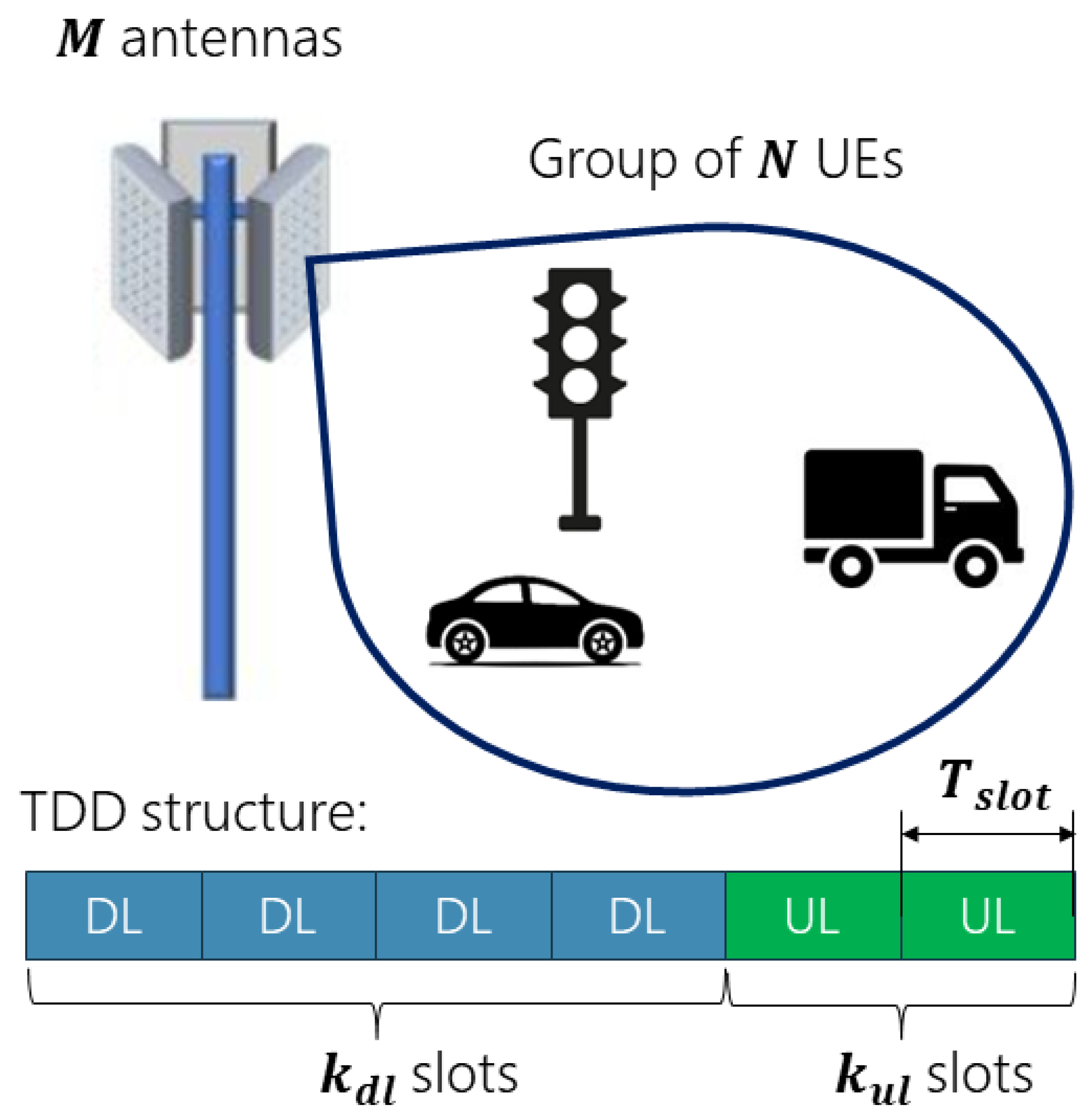
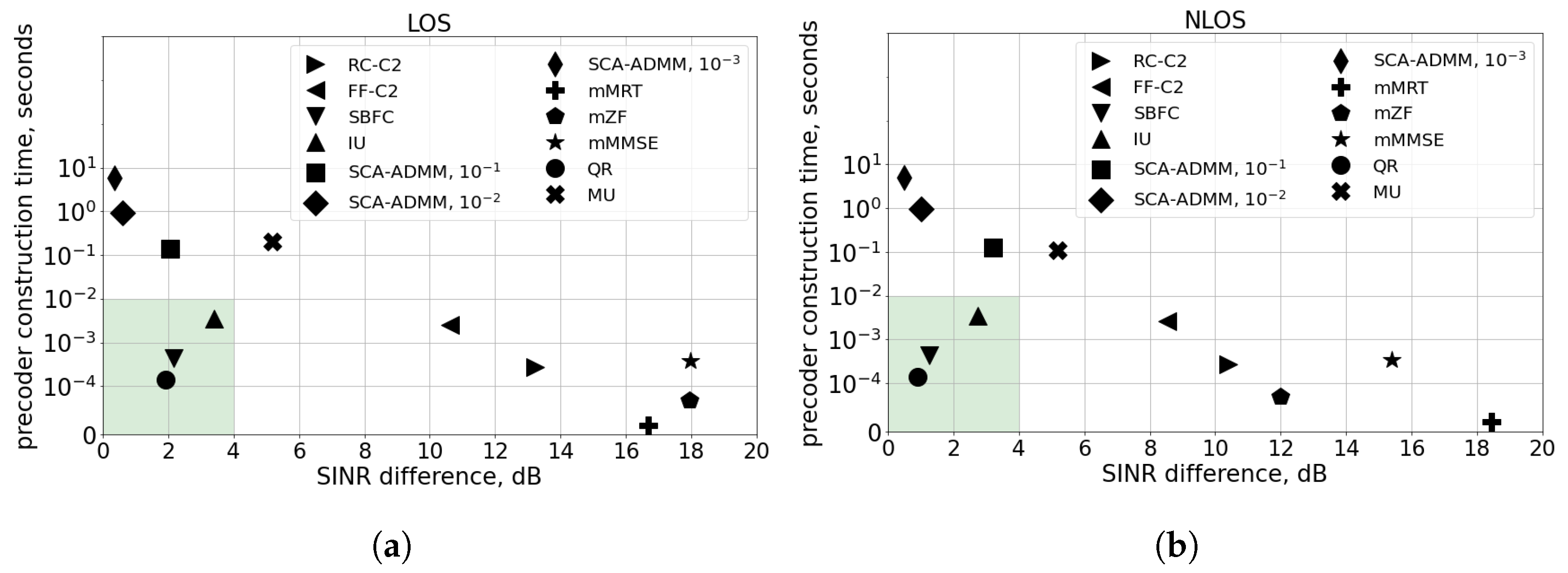
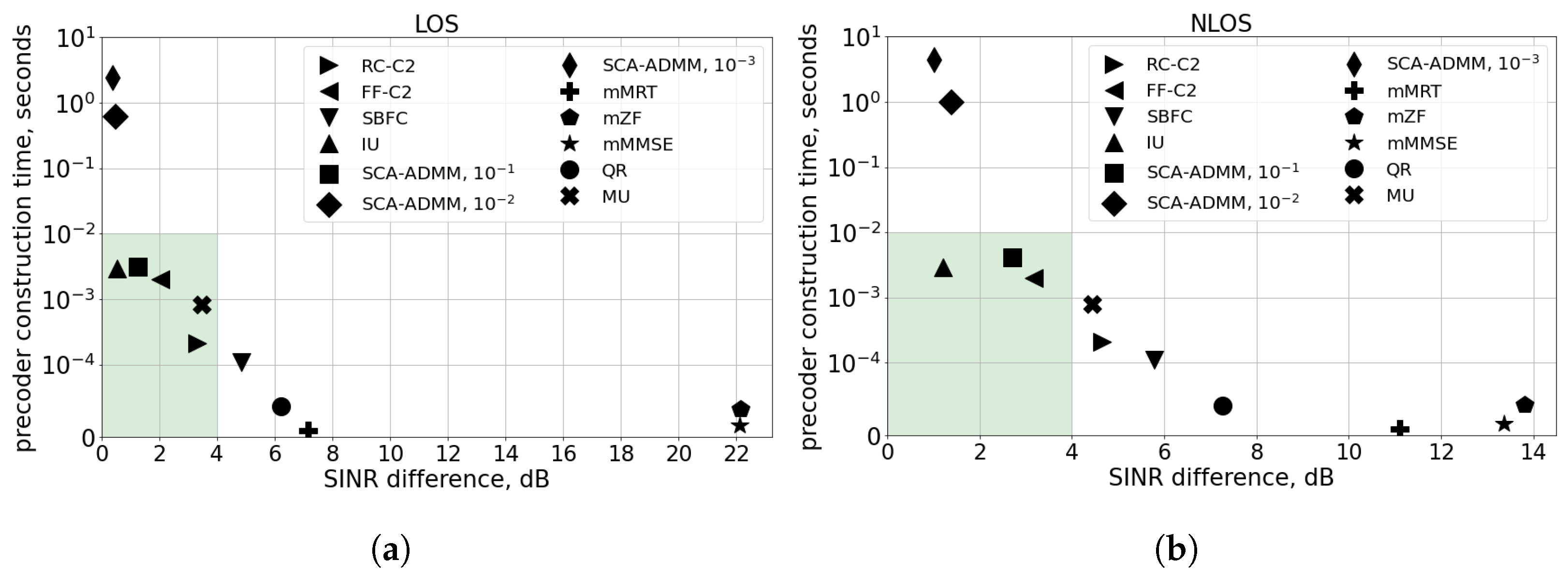
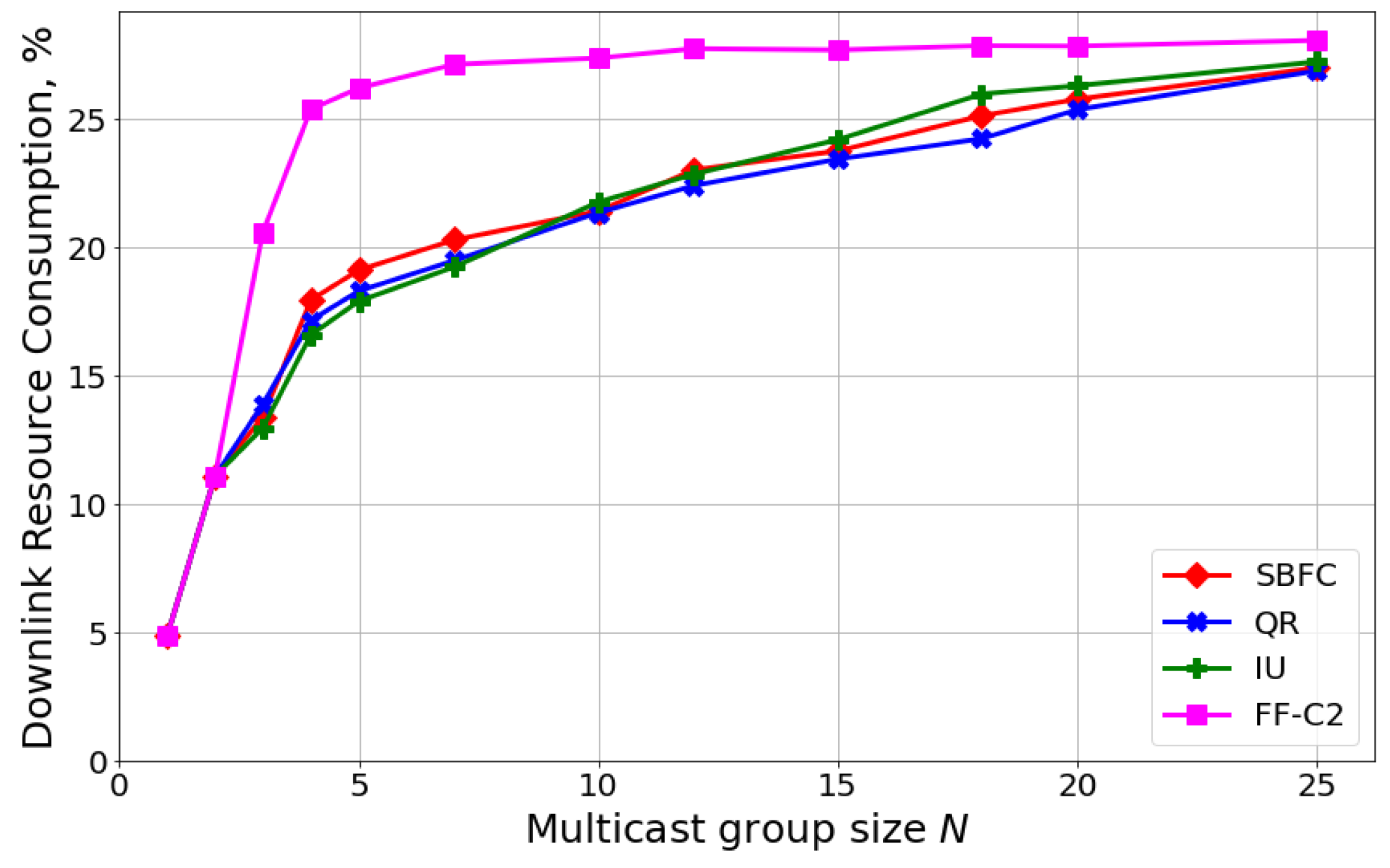
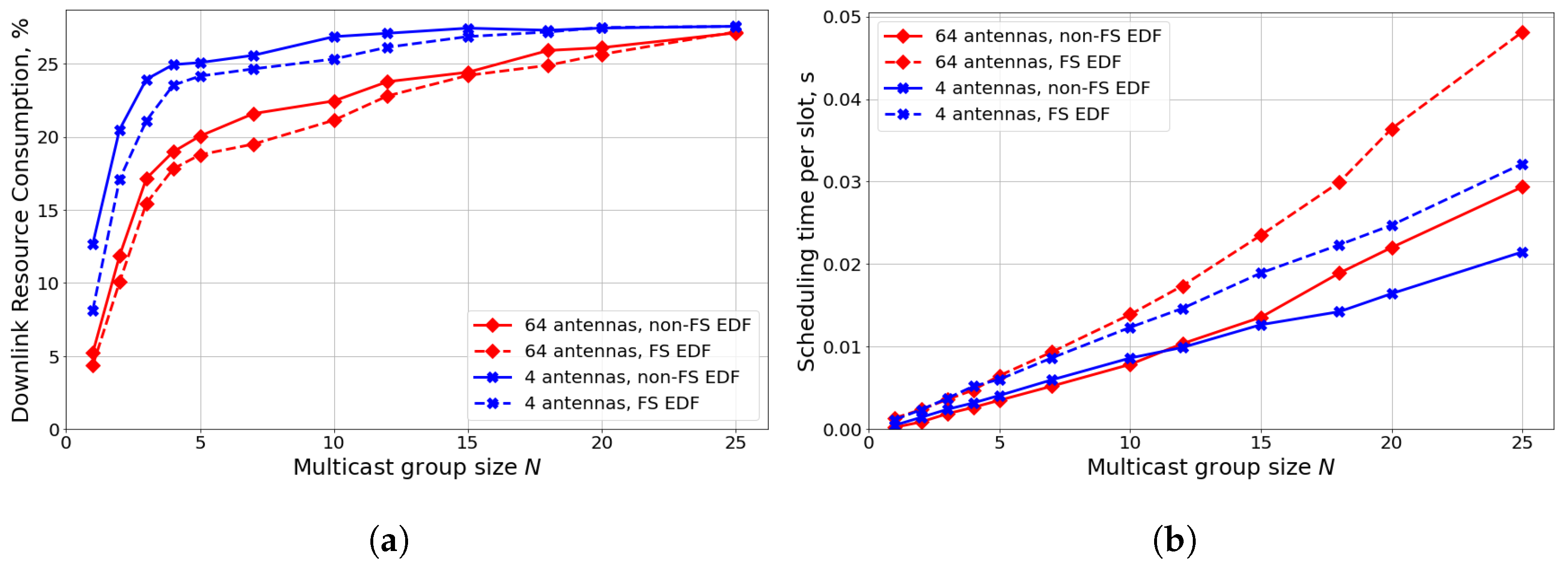
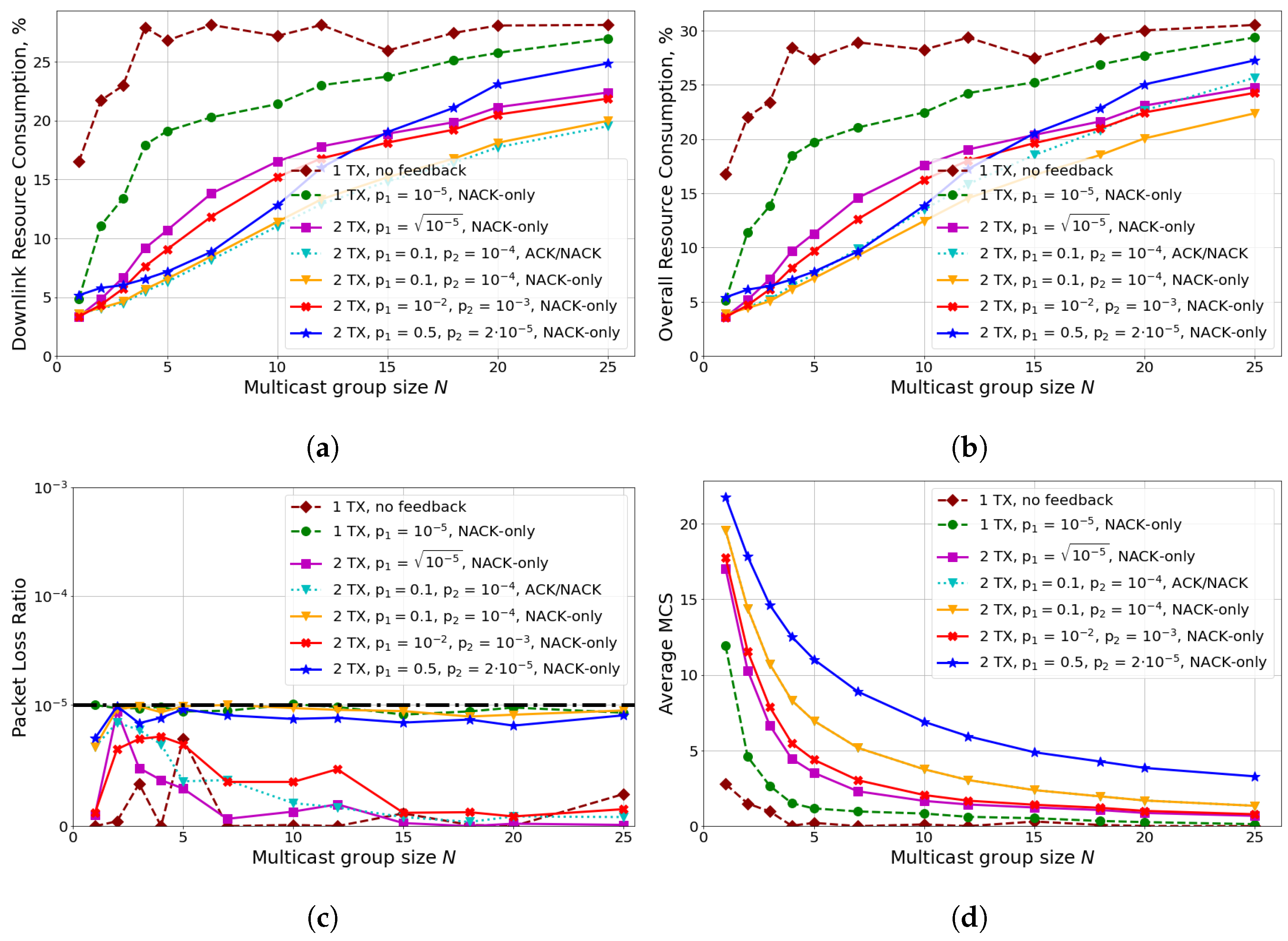
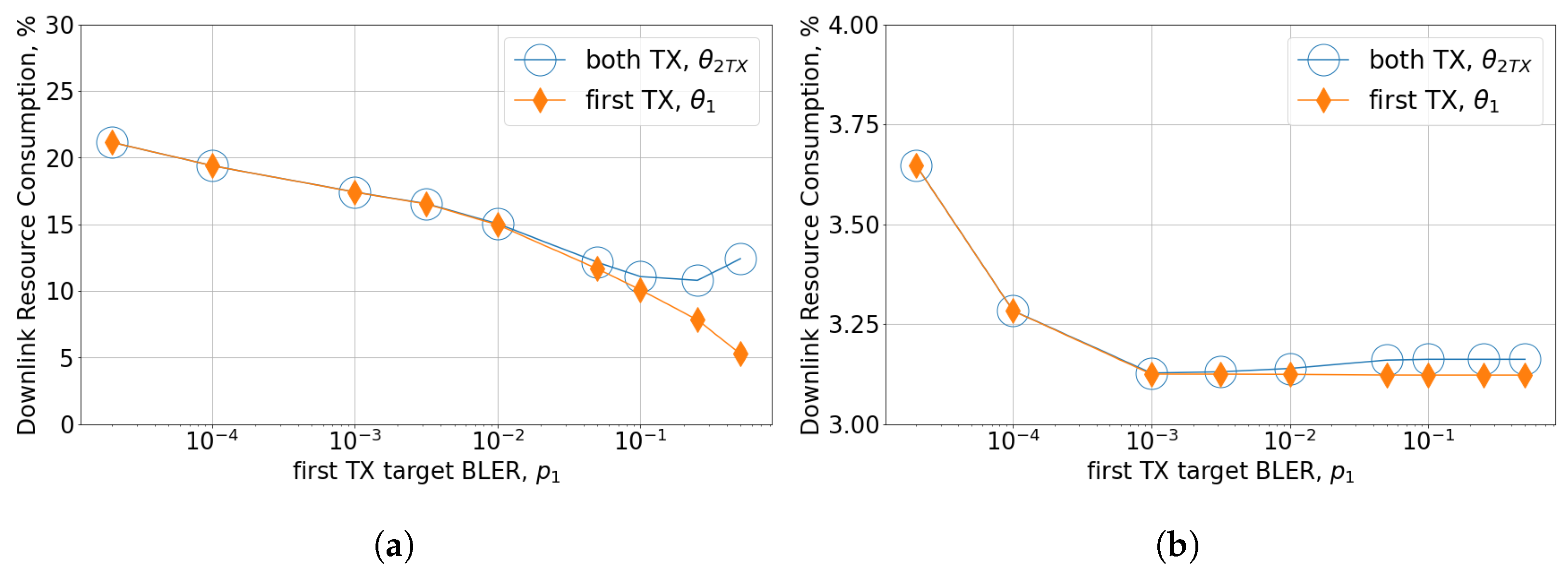
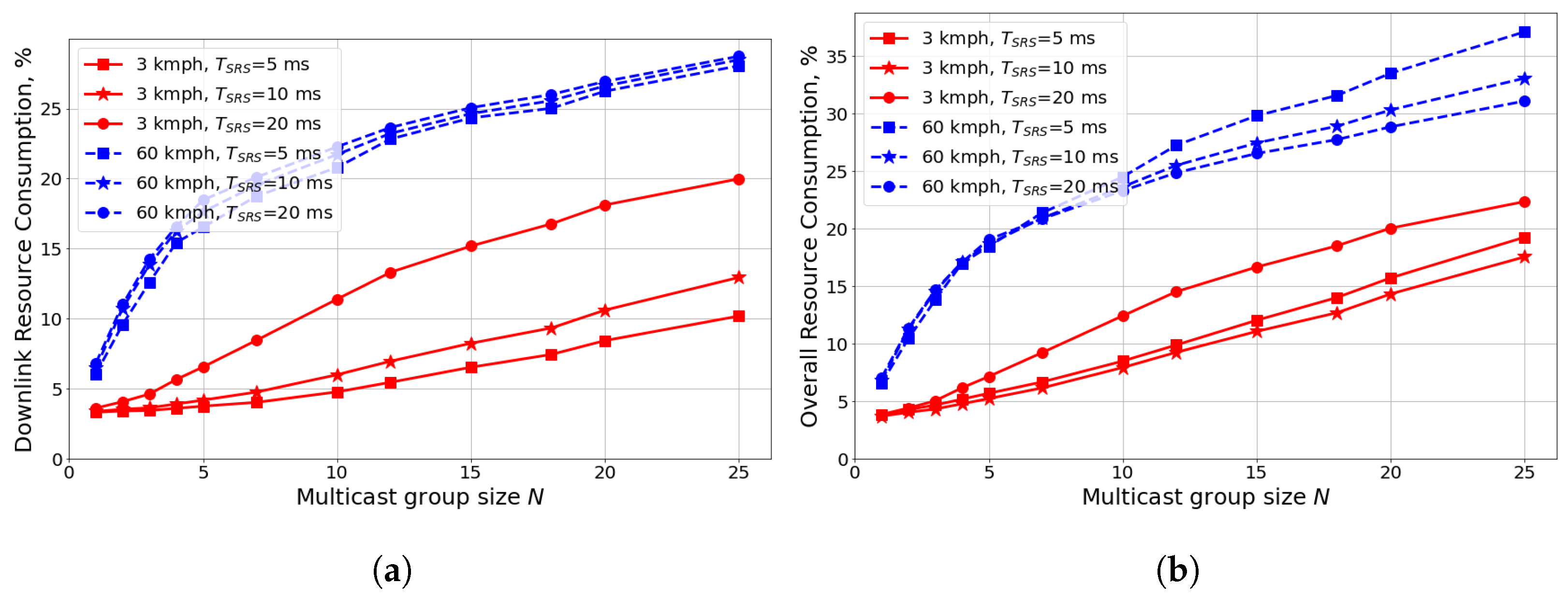
| Problem | Multicast eMBB | Multicast URLLC | Unicast URLLC | ||
|---|---|---|---|---|---|
| The maximum number of transmission attempts (TXs) | One TX attempt | Two TX attempts (if the delay budget allows, use HARQ retransmissions) | ⇐ | Two TX attempts (if the delay budget allows, use HARQ retransmissions) | |
| Feedback Scheme | No feedback | X | NACK-only feedback | X | ACK/NACK feedback |
| Sounding period | The optimal period is scenario-dependent | X | Optimization of the sounding period is fruitful only for low-mobility scenarios | X | The optimal period is scenario-dependent |
| Precoder selection | QR, SBFC, IU, MU, SCA-ADMM, FF-C2,RC-C2. | ⇒ | QR, SBFC, IU | MRT, ZF, MMSE | |
| Scheduler | FS PF and its modifications. | Multicast adaptation of (non-)FS EDF | FS EDF | ||
| MCS selection | Fixed subtraction (eOLLA) | Multicast adaptation of OLLA with two target BLERs | OLLA |
| Time Scale | Problem | Possible Solutions | Recommendations |
|---|---|---|---|
| Long-term parameters | The maximum number of transmission attempts (TXs) | For mURLLC requirements, typically one or two transmission attempts are possible (see Section 3.1). | If the latency budget allows HARQ retransmissions, they shall be enabled. They reduce resource consumption up to three times compared with a single transmission attempt (see Section 4.4). |
| Feedback Scheme | Three schemes are described in 3GPP specifications (see Section 3.2):
| Out of the three schemes, the NACK-only feedback provides the lowest overall (DL+UL) resource consumption (see Section 4.6). | |
| Sounding period | The sounding period can be tuned by the gNB. A higher sounding period improves the quality of the precoder (i.e., increases SINRs at UEs) but increases UL overhead (see Section 3.3). | For low UE speed, sounding period optimization can reduce resource consumption up to 40%. For high UE speed, a high sounding period only increases UL overhead without a notable reduction of DL resource consumption (see Section 4.7). | |
| Short-term parameters (for each TX) | Precoder | Existing algorithms can be classified into (see Section 3.4): | For a low number of antennas, iterative algorithms provide the highest performance with reasonable complexity. For the M-MIMO case, orthogonal subspace construction algorithms provide better results (see Section 4.2). |
| RB allocation (scheduler) | The EDF scheduler aims to minimize the latency required for mURLLC [28]. It can be implemented in several ways (see Section 3.5):
| FS EDF provides notable gain only for a low number of UEs and a low number of antennas at the gNB. In other cases, Non-FS EDF provides the same performance with up to 40% lower complexity (see Section 4.3). | |
| MCS selection | MCS selection depends on the feedback scheme (see Section 3.6). | The usage of feedback and multicast OLLA up to three times reduces the overall resource consumption. In the case of two TXs, different target BLERs for the first and second TXs reduce resource consumption up to 40% compared with the same BLERs (see Section 4.5). |
| Parameter | Value |
|---|---|
| Carrier frequency | GHz |
| Bandwidth | 100 MHz |
| TDD structure | , , ms |
| Number of RBs | 256 |
| Channel model | 3GPP TR 38.901, Urban Macro |
| gNB/UE antennas | 64 or 4 |
| UE antennas | 1 |
| gNB/UE TX power | 33/23 dBm |
| Traffic | CBR: 400 bytes, 1 ms period |
| QoS requirements | , ms |
| Simulation time | 1000 s, 40 runs |
Disclaimer/Publisher’s Note: The statements, opinions and data contained in all publications are solely those of the individual author(s) and contributor(s) and not of MDPI and/or the editor(s). MDPI and/or the editor(s) disclaim responsibility for any injury to people or property resulting from any ideas, methods, instructions or products referred to in the content. |
© 2024 by the authors. Licensee MDPI, Basel, Switzerland. This article is an open access article distributed under the terms and conditions of the Creative Commons Attribution (CC BY) license (https://creativecommons.org/licenses/by/4.0/).
Share and Cite
Krasilov, A.; Lebedeva, I.; Yusupov, R.; Khorov, E. Resource-Efficient Multicast URLLC Service in 5G Systems. Sensors 2024, 24, 2536. https://doi.org/10.3390/s24082536
Krasilov A, Lebedeva I, Yusupov R, Khorov E. Resource-Efficient Multicast URLLC Service in 5G Systems. Sensors. 2024; 24(8):2536. https://doi.org/10.3390/s24082536
Chicago/Turabian StyleKrasilov, Artem, Irina Lebedeva, Ruslan Yusupov, and Evgeny Khorov. 2024. "Resource-Efficient Multicast URLLC Service in 5G Systems" Sensors 24, no. 8: 2536. https://doi.org/10.3390/s24082536
APA StyleKrasilov, A., Lebedeva, I., Yusupov, R., & Khorov, E. (2024). Resource-Efficient Multicast URLLC Service in 5G Systems. Sensors, 24(8), 2536. https://doi.org/10.3390/s24082536





